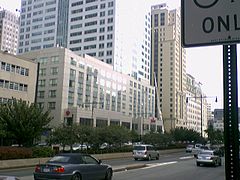Downtown Brooklyn
Since the rezoning of Downtown Brooklyn in 2004, the area has been undergoing a transformation, with $9 billion of private investment and $300 million in public improvements underway.
In 2017, New York University announced that it would invest over $500 million to renovate and expand the NYU Tandon School of Engineering and its surrounding Downtown Brooklyn-based campus.
Walt Whitman was fired from his job as a reporter at the Brooklyn Eagle due to his support for the Wilmot Proviso when he lived at Willoughby and Myrtle Avenues.
A group of buildings at 223, 225, 227, 231, 233, and 235 Duffield Street, in addition to the African Wesleyan Methodist Episcopal Church located in MetroTech Center, were believed to be among the safehouses.
[6] The middle 19th century growth of the Port of New York caused shipping to spill over into the City of Brooklyn; many buildings now used for other purposes were built as warehouses and factories.
The program included plans for new buildings for City and State agencies, significant street widening and major housing construction in adjacent areas.
By the late 1960s, the patterns of transition that affected much of urban America initiated concern to protect the borough's Central Business District from deterioration.
"[citation needed] In re-affirming Downtown Brooklyn's central role and identifying its problems, the Plan was optimistic that a combination of public and private efforts would stimulate office and commercial construction.
A 23-story privately financed office tower at Boerum Place and Livingston Street opened in 1971 and the anticipated growth of the Brooklyn Academy of Music (BAM) succeeded far beyond expectations, giving this cultural institution an important role as a symbolic anchor amid increasing decay during the following decade.
After suffering with the rest of New York through the fiscal crisis of the mid-1970s, Borough President Howard Golden, first elected in 1977, moved forward with a more aggressive economic development program to revitalize Downtown Brooklyn.
According to the document, Downtown Brooklyn could become the city's third-largest business district because of its proximity to Lower Manhattan (closer by subway than Midtown).
Since the rezoning of parts of Downtown Brooklyn in 2004 to allow for denser residential development, the area has seen the arrival of new condominium towers, townhouses, and office conversions.
[citation needed] A New York Sun article from November 7, 2007, reports on the arrival of Downtown Brooklyn as a 24/7 community, estimating that 35,000 residents will come to the area in the next five years.
The housing increase has also resulted in positive effects on other aspects of Downtown Brooklyn's economy as well, with revenues for the area's hospitality industry having tripled since 2004.
Alongside immediately adjacent neighborhoods, the general area encompasses Brooklyn Borough Hall, the Justice Ruth Bader Ginsburg Municipal Building, the Kings County New York State Courthouse and the Eastern District of New York's Theodore Roosevelt United States Courthouse.
Attractions within the area include the Fulton Mall, the Brooklyn Academy of Music, the New York Transit Museum and Barclays Center.







